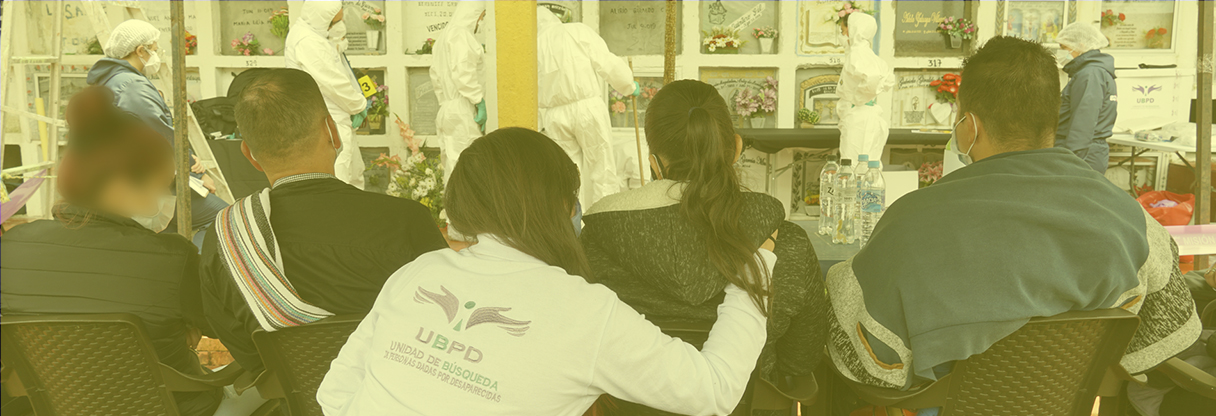Unit for the Search of Disappeared Persons (UBPD) Snapshot 3
Humanitarian Action by the Unit for the Search of Disappeared People (UBPD): The Case of Samaná
The first site of humanitarian action for the UBPD has been in Samaná, in the department of Caldas. This work has involved the location of 24 victims who had been killed, and progress both in their recovery and the possible dignified return of their remains to relatives living in the area. This snapshot analyses the progress being made by the UBPD in this humanitarian work.

Image taken from the webpage of the Unit for the Search of Disappeared People (09.12.2020)
Regional Search Plan – Magdalena Medio Caldense
Since its implementation, the UBPD has defined a National Search Plan as part of its commitment to the humanitarian search for and identification of persons considered missing in the context of the armed conflict. This plan includes (1) data collection, organisation and analysis, (2) locating those missing, (3) exploration of graves and recovery of bodies, (4) identification, and (5) reunion or dignified return.
Through the Regional Search Plan of Magdalena Medio Caldense, the UBPD began the process of searching for 187 people reported missing in four municipalities: La Dorada, Samaná, Norcasia and Victoria. This was possible thanks to the work and information shared by families, the authorities and victims’ organisations such as the Center for Studies on Conflict, Violence and Social Coexistence (CEDAT) of the University of Caldas; the Foundation for Community Development of Samaná (FUNDECOS); and the Colombian Interdisciplinary Team for Forensic Work and Psychosocial Assistance (EQUITAS). The UBPD also obtained additional information through the review of routes and maps, social mapping workshops with the communities, and testimonies from people who participated in the hostilities or who have information on the places used to dispose of bodies.
Progress in Samaná
From 26 October to 11 November, 2020, the UBPD began two further phases in Samaná. Firstly, intervention at the Cemetery of San Agustín led to the location of 24 victims who were registered in the cemetery between 2002 and 2007. This was a period marked by a rise in violence in this region. According to the UBPD, “90% of the recovered victims are men between 17 and 45 years old” and. the National Institute of Forensic Medicine and Sciences (Legal Medicine) has found that these victims show signs of violence, including impacts from firearm projectiles, signs of torture, and dismemberment.
In a second phase, the UBPD has advanced in the process of identifying these fatalities by taking biological samples in order to create their genetic profiles. The unit took 182 samples from relatives who are searching for their loved ones in Samaná and the townships of San Diego and Florencia. In Bogotá, Legal Medicine carried out a sampling from 50 families related to this case.
These samples are intended to support and expedite the identification of the remains and the dignified return of the recovered bodies to their families. The genetic information of these samples is compared with that of the 24 victims recently recovered in the cemetery. If there is a genetic match between the samples taken, the UBPD, alongside the Internal Working Group for the Search, Identification and Delivery of Disappeared Persons of the Office of the Attorney General, will contact the families to proceed with the dignified return of the remains, respecting the needs and cultural practices of their relatives. These families will also first receive psychosocial care from the Victims Unit, the Ministry of Health, other civil society organisations and NGOs that have supported the UBPD.
Reconstruction of Historical Memory
Without prior historical memory work, the search for people who have disappeared would be far more complex. In 2018, CEDAT, FUNDECOS and EQUITAS started a project entitled “Construction of Memory and Truth from the voices of the victims of Magdalena Medio”, which supports the reconstruction of the historical memory of the families of victims of enforced disappearance in Samaná. This project achieved the documentation of 85 cases of forced disappearance in this municipality, allowing the construction of a universe of disappeared persons and their characteristics. This includes who the victims are, how old they were, why they were disappeared, and the type of disappearance, amongst others. This project also succeeded in identifying strategic points that facilitated the initiation of the search by the UBPD. However, gaps were also identified at the institutional level. 39 of the 85 registered cases do not appear in the Legal Medicine Corpses Network Information System (SIRDEC). This implies that these 39 victims have been doubly disappeared and unfortunately, gaps are not limited to this case but replicated at a national level.
Embrace Dialogue celebrates the humanitarian action carried out by the UBPD, and recognises the contribution of historical memory initiatives to the search for the disappeared. We invite state institutions to make use of this information to avoid the re-disappearance of victims missing and killed in the armed conflict.


